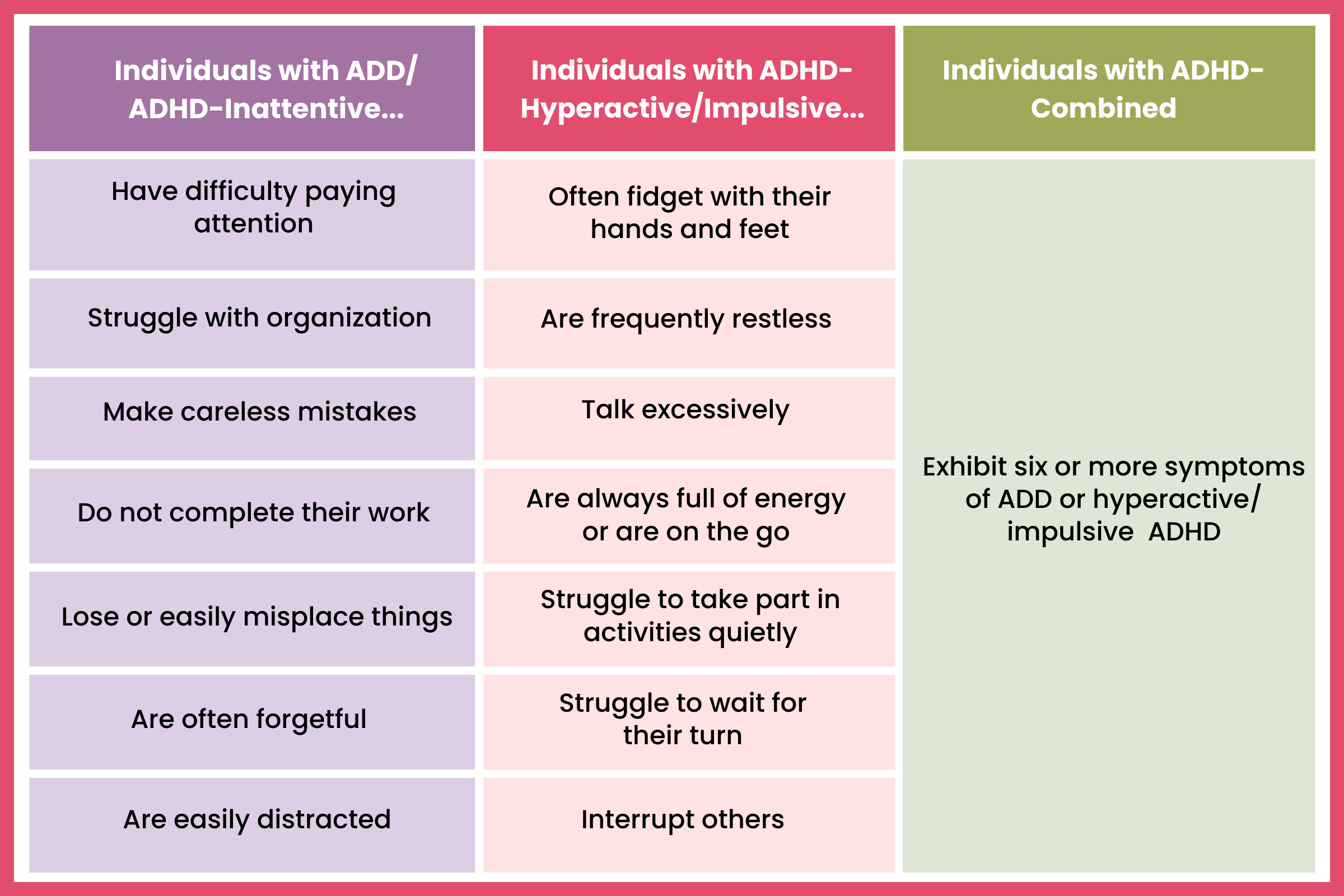|
Key Takeaways:
- ADD and ADHD are the same disorder.
- The main difference between ADD and ADHD is the symptoms that manifest most prominently from the condition.
- ADD/ADHD can be treated using a combination of therapy and medication.
|
Mental health terms can sometimes be confusing, especially for people who aren’t professionals in the field. You may have heard of both ADD and ADHD before and wondered if there was even a difference between the two conditions. Many people use these terms interchangeably. Here, you’ll learn the differences and similarities between ADD vs. ADHD, their causes, and how to treat and manage them.
What is ADHD?
ADHD stands for attention deficit hyperactivity disorder, and it is one of the most common mental disorders that affect people’s behavior, particularly children. Individuals who have ADHD tend to be impulsive, hyperactive, and often struggle to focus and pay attention.
What is ADD?
ADD stands for attention deficit disorder, and it is a type of ADHD. As a result, some of the symptoms and character traits that are associated with ADD are also related to ADHD. ADD is the inattentive type of ADHD, which means that individuals who have this disorder may struggle to remember things and pay attention without distractions. They may also struggle to be productive at work and school.
What’s the Difference Between ADHD and ADD?
To understand the difference between ADD and ADHD, we must look back on the histories of these conditions. From 1980 to 1987, the third edition of the Diagnostic and Statistical Manual of Mental Disorders (DSM-III) used the term Attention Deficit Disorder (ADD). They classified the disorder into two types: with or without hyperactivity. In 1994, the term Attention Deficit Hyperactivity Disorder was introduced to explain the conditions and its subtypes better.
In short, while the terms are different and are used interchangeably, the condition they describe is essentially the same.
The best way to understand ADHD is to consider which symptoms are most prominent, whether that’s inattentive, hyperactive, or mixed. It is also important to remember that having ADHD can still apply even if an individual doesn’t have hyperactive or impulsive behaviors.
To understand this better, let’s move into the types of ADHD.
Types
Three types of ADHD manifest somewhat differently and have a unique set of symptoms.
ADHD Predominantly Inattentive Presentation
ADHD Predominantly Inattentive refers to individuals with an ADHD condition who are not hyperactive. They do not have the high energy level observed in others with ADHD. People with this form of the condition may seem shy, withdrawn, or lacking in social skills. This subtype of ADHD often goes undiagnosed because the symptoms may be considered daydreaming.
ADHD Predominantly Hyperactive-Impulsive Presentation
People with this type of ADHD have plenty of energy and are always moving in ways that cause issues in daily life. This form is more apparent than the inattentive type.
ADHD Combined
This type of ADHD has symptoms of both hyperactivity/impulsivity and inattention. People who deal with combined type ADHD struggle with both being hyperactive and impulsive while struggling to pay attention.
Causes
The exact cause of ADHD is not fully understood. However, experts do believe that a combination of factors contributes to the development of the condition.
Genetics
Studies have shown that ADHD tends to run in families [*]. In most cases, the genes an individual inherits from their parents play a significant role in the development of the condition. Parents and siblings of someone with ADHD are also more likely to have the condition themselves. However, it is important to note that the way ADHD is inherited is more complex than being caused by a single genetic fault.
Brain Structure and Function
Research has shown that structural differences in various parts of the brain can influence the condition [*]. Certain brain scans have suggested that some areas of the brain may be smaller in people with ADHD.
Risk Factors
There are some people believed to be more at risk for ADHD, including individuals with epilepsy, those who were born prematurely or with a low birth weight, and people with brain damage.
Symptoms
People who have the predominantly inattentive ADHD type (also known as ADD) mainly struggle with poor focus, forgetfulness, organization, and listening. Some symptoms, as listed in the Diagnostic and Statistical Manual of Mental Disorders (DSM-V), are the following:
- Difficulty paying attention
- Struggles with organization
- Makes careless mistakes
- Fails to pay attention to details
- Does not follow through with instructions
- Does not complete work
- Does not listen when spoken to
- Dislikes and avoids mentally challenging tasks
- Loses or misplaces things
- Distracted easily
- Often forgetful
People who have hyperactive or impulsive ADHD, on the other hand, will display the following symptoms:
- Often fidgets with hands and feet
- Feels the need to leave a seat for no apparent reason
- Frequently restless
- Struggles to take part in leisurely activities quietly
- Always full of energy and on the go
- Excessive talking
- Struggles to wait for their turn
- Interrupts others
- Aggression
People who suffer from the combined type of ADHD exhibit six or more symptoms of ADD or hyperactive/impulsive ADHD.
Diagnosis
Healthcare professionals such as pediatricians, psychologists, and psychiatrists can diagnose ADHD using guidelines such as the DSM. They gather information through interviews to assess an individual’s behavior and how it compares with people of the same age. For instance, some people may display ADHD aggression that is absent in their peers who do not have the condition. Healthcare providers may also use standardized rating scales to document such behaviors.
Healthcare professionals should also conduct a physical exam and consider the individual’s medical history to check for other conditions that may affect behavior. Some can mimic ADHD or cause ADHD-like behaviors, including:
- Recent major life events (e.g., divorce, death in the family, move, etc.)
- Sleep issues
- Undetected seizures
- Thyroid problems
- Depression
- Anxiety
- Lead toxicity
Treatment
Fortunately, there are various ways that ADD/ADHD can be treated.
Therapy
Therapy is one treatment method that can help individuals with ADHD. For instance, you or a loved one may be experiencing symptoms like ADHD paralysis, or the inability to concentrate and focus on certain tasks or things. A mental health professional would employ behavioral therapies such as cognitive behavioral therapy or dialectical behavior therapy to address those symptoms. Therapy may also take place in individual, group, and family settings. A therapist may also use tools like ADHD worksheets, especially for children.
Medication
Something that ADD and other types of ADHD do have in common is that both use similar medications in their treatments. These involve non-stimulants, antidepressants, or psycho-stimulants. Medicines like Ritalin, Adderall, and Concerta are common brand names of stimulants that increase alertness and focus, helping manifestations of ADHD like mental paralysis. Non-stimulant drugs, on the other hand, help people regulate their emotions better. Antidepressants also help since other mental health disorders, such as depression and anxiety, often co-occur with ADHD.
ADHD and ADD in Children vs. Adults
Anyone of any age can have ADD or ADHD. However, children often show symptoms differently compared to adults. For instance, a child with ADHD may be extremely boisterous to the point of climbing things and running around. Teens and adults may exhibit hyperactivity more by fidgeting and restlessness. Adults with ADD or ADHD also tend to be more forgetful and often lose things like their keys, wallets, phones, and other important belongings.
Because teens and adults are more mature than children, ADHD symptoms appear to improve with age. However, adults who have had ADHD in childhood usually continue to suffer from the disorder in some capacity throughout adulthood.
ADHD can be more difficult to diagnose in children than in adolescents and adults because kids are naturally more hyperactive and impulsive. ADD, or the inattentive type of ADHD, is more difficult to diagnose in all people.
Similarities Between ADHD and ADD
Since ADHD and ADD refer to the same condition, similarities between the two overlap significantly. The main difference is the subtype of ADHD that is classified as ADD (ADHD Predominantly Inattentive) and its accompanying symptoms. In my experience, when someone in the mental health field says “ADD,” it is generally understood that they are referring to ADHD Inattentive Presentation.
The Bottom Line
Understanding what defines ADD or ADHD is essential to helping people get better. While the terms can be used interchangeably, it is incredibly valuable to know the subtypes of ADHD so that individuals can be given the proper treatment. Whether you have a hyperactive child or you are experiencing choice paralysis regularly, knowing the nuances of ADHD is undeniably beneficial. Remember that consulting a mental health professional is always a good action step to take.
Explore our collection of ADHD worksheets to provide additional support to those who might be struggling with ADHD symptoms.
References:
- Faraone S & Larsson H. Genetics of attention deficit hyperactivity disorder. 11 June 2018.
- Agoalikum E, Klugah-Brown B, Wu H, et al. Structural differences among children, adolescents, and adults with attention-deficit/hyperactivity disorder and abnormal Granger causality of the right pallidum and whole-brain. 14 Feburary 2023.







